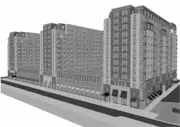Like the Energizer bunny, the residential real estate market boom in Hudson County keeps going and going.
Like the Energizer bunny, the residential real estate market boom in Hudson County keeps going and going. Not even recent interest rate hikes or analysts’ predictions of an imminent stock market correction have slowed the red-hot market.
Homes priced at $500,000 and apartments renting for $3,000 per month are still being snatched off the market quickly.
Analysts, developers and brokers say that the trend is not likely to end soon, thanks to a strong economy and the demographics of an aging Baby Boom generation.
Recently developers say they have seen the demand grow beyond the borders of Hoboken, where young 20 and 30-somethings who work in Manhattan have flocked to take advantage of the Greenwich Village-like atmosphere and the short commute across the river via the PATH trains.
While apartments situated "steps from the PATH" still fetch the highest prices, brokers like Barbara Tulko, who has offices in Jersey City, Weehawken, and West New York, say that many people who can not afford to live in Hoboken are buying and renting in areas close to it.
"People are considering things that they would never would have considered before because of these rising prices," Tulko said. "It used to be that if you wanted to try sell something up in the Jersey City Heights area, people would look at you like you had two heads. Now all of a sudden everybody w ants to go look up at Jersey City Heights. I’ve seen rents climb from $1,000 to $1,500 for the same apartment in a year there."
"And it is not just there," she added, "it’s a lot of Jersey City, it’s the Boulevard East section of West New York, and it’s North Bergen too."
In Hoboken, the housing boom has led to new construction on previously vacant lots and in areas once thought to be undesirable.
The northern waterfront is home to two new luxury complexes, the Shipyard and Hudson Cove Apartments, while construction on a new 13-story residential apartment building on the southern waterfront began earlier this month.
Meanwhile, new projects with apartments fetching four digit rents have sprung up on the so-called "dead presidents" streets in the western part of town that were once considered off-limits by developers due to their proximity to the federally-subsidized housing projects in the southwest corner of the city.
Even as new buildings are squeezed into the dwindling spaces in the mile square city, some brokers said that the city’s investment in new parks, like the recently opened Pier A park next to the PATH station, makes the area even more desirable.
"Hoboken keeps getting better and better," said Dan Voehinger of Re/Max realtors. "The city has opened a number of new parks recently, and that is a big draw for some people."
While developers have struggled to build enough apartments in Hoboken to keep up with the demand, it is actually the lack of new housing stock that is helping to fuel the boom in places like Weehawken. Brokers say that the value of many homes there jumped by as much as 15 to 20 percent in the last year.
"Weehawken is a bit of phenomenon because there is not that much opportunity for construction," said Tulko. "Nobody is adding to the housing stock and nobody is selling there because it is so expensive to move somewhere else, so we have a situation there where anything that opens up is gone in a blink of an eye."
The gradual gentrification of places like Weehawken, West New York and Jersey City Heights is likely to be followed by investments by the business community to take advantage of the spending power of the newly-arrived renters and home owners.
"It won’t be long before we see a Starbucks in Weehawken," Tulko predicted.
Although the boom is primarily being driven by people who work in Manhattan and are looking for a higher quality of life on this side of the Hudson, Dr. James Hughes, the Dean of the Public Policy and Planning School at Rutgers University, believes that there are strong secondary markets fueling the fire.
He points to new construction of office buildings in Hudson County along the waterfront, including the Newport area around Jersey City, and the southern waterfront of Hoboken where there are plans to build a new one million square foot facility.
"The growth of office space within Hudson County is causing a whole new wave of housing demand that is driving up prices," Hughes said.
Hughes, who has authored a number of books on housing and demographics, also pointed to aging baby-boomers as a group that was also contributing to the nearly overwhelming demand for housing in Hudson County.
"You have so called empty nesters who are people whose kids are grown and they are rattling around in their big suburban houses with too much space," he explained. "They were really constrained before, but now they want to reposition themselves in the housing market with something that is a little more urban and a little closer to Manhattan. As we move further into the decade and the baby boomers continue to age that will become a very large market."
